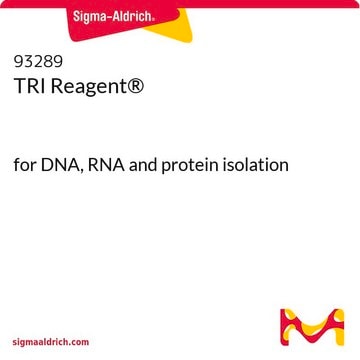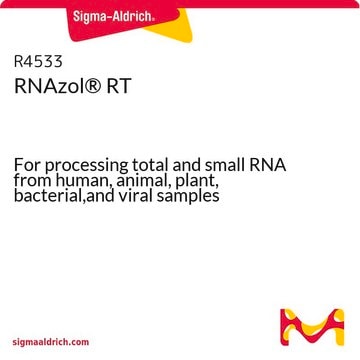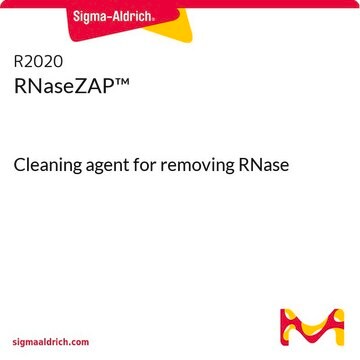This product is intended to simply maintain the integrity of the DNA and RNA during extraction and does not play a role in the disruption or digestion of the sample. Both, large and small nucleic acid molecules will be recovered. The primary factor in determining the size of the recovered nucleic acid fragments will be the method utilized to disrupt the cells or tissues.
Wichtige Dokumente
T9424
TRI-Reagenz®
For processing tissues, cells cultured in monolayer or cell pellets
Synonym(e):
TRI Reagent® RNA Isolations Reagens
Größe auswählen
Größe auswählen
About This Item
Empfohlene Produkte
Qualitätsniveau
Verwendung
mL sufficient for 107 cells
mL sufficient for 100 mg tissue (or)
Lagertemp.
2-8°C
Suchen Sie nach ähnlichen Produkten? Aufrufen Leitfaden zum Produktvergleich
Allgemeine Beschreibung
RNA, DNA und Proteine werden durch Homogenisierung oder Lyse der Gewebeprobe in TRI-Reagenz® gelöst. Durch die Zugabe von Chloroform oder 1-Brom-3-chlorpropan und die anschließende Zentrifugierung wird das Gemisch in drei Phasen aufgetrennt: eine wässrige Phase mit RNA, eine Interphase mit DNA und eine organische Phase mit Proteinen. Nach der Phasentrennung kann jede der Komponenten isoliert werden.
Anwendung
- für die Isolierung von Gesamt-RNA aus unterschiedlichen Arten von Geweben und Zellen [1][2][3][4]
- für die Lyse von Monozyten [5]
- für die Isolierung zytoplasmatischer RNA aus mit SARS-CoV infizierten Vero-Zellen [6]
- für die Isolierung von Gesamt-RNA aus MDMs (aus Monozyten gereifte Makrophagen), die mit dem Influenza-A-Virus (H5N1) infiziert sind [7]
- zur Herstellung eines viralen Lysats aus einer SARS-CoV-Kultur für die Erzeugung eines Klons, wobei das S-Glykoprotein bei der Entwicklung eines SARS-CoV-Impfstoffs kodiert wird [8]
Die mit TRI-Reagenz® isolierte(n) RNA, DNA und Proteine können außerdem für Downstream-Anwendungen wie z. B. Klonierung, PCR, RT-PCR, Northern Blots, mRNA-Isolierung, In-vitro-Translation, RNase-Schutzassays, Restriktionsenzymverdau, Southern Blots, SDS-PAGE und Western Blots verwendet werden.
Leistungsmerkmale und Vorteile
Vielseitig einsetzbar: TRI-Reagenz® eignet sich gut für große oder kleine Mengen an Gewebe oder Zellen und ist mit vielen Proben menschlichen, pflanzlichen, Hefe-, bakteriellen und viralen Ursprungs einsetzbar.
Effizient: TRI-Reagenz® liefert bessere Erträge als traditionelle Guanidiniumthiocyanat-/Cäsiumchlorid-Methoden. Das gesamte RNA-Extraktionsverfahren kann mit frischem Ausgangsgewebe bzw. frischen Ausgangszellen in weniger als einer Stunde durchgeführt werden.
- Leicht skalierbare RNA-Isolation
- Vielseitig einsetzbar mit: Menschen, Pflanzen, Hefe, Bakterien oder Viren
- Bessere Erträge als traditionelle Guanidinthiocyanat/Cäsiumchlorid-Methoden
Sonstige Hinweise
Rechtliche Hinweise
Ähnliches Produkt
Signalwort
Danger
Gefahreneinstufungen
Acute Tox. 3 Dermal - Acute Tox. 3 Inhalation - Acute Tox. 3 Oral - Aquatic Chronic 2 - Eye Dam. 1 - Muta. 2 - Skin Corr. 1B - STOT RE 2
Zielorgane
Nervous system,Kidney,Liver,Skin
Zusätzliche Gefahrenhinweise
Lagerklassenschlüssel
6.1A - Combustible acute toxic Cat. 1 and 2 / very toxic hazardous materials
WGK
WGK 2
Flammpunkt (°F)
174.2 °F - closed cup
Flammpunkt (°C)
79 °C - closed cup
Hier finden Sie alle aktuellen Versionen:
Besitzen Sie dieses Produkt bereits?
In der Dokumentenbibliothek finden Sie die Dokumentation zu den Produkten, die Sie kürzlich erworben haben.
Kunden haben sich ebenfalls angesehen
Artikel
Die Verfügbarkeit von einfachen Verfahren zum Aufreinigen von DNA und RNA hat die Analyse und Charakterisierung des Genoms und der Genexpression in hohem Maß erleichtert. Es besteht eine Anforderung, DNA und RNA schnell und praktisch aus verschiedenen zellulären Quellen, einschließlich Gewebe aus Tier-, Pflanzen- und Bakterienkulturen, zu isolieren.
Simple DNA/RNA purification methods aid genome analysis from various sources, enhancing research efficiency.
Protokolle
TRI Reagent ist ein einstufiges RNA-Isolierungsreagens, das die gleichzeitige Isolierung von DNA, RNA und Protein ermöglicht. In diesem Protokoll werden die Probenvorbereitung sowie die Extraktion verschiedener Proben und die Fehlerbehebung beschrieben.
TRI Reagent enables simultaneous DNA, RNA, and protein isolation with sample prep guidelines and troubleshooting.
Procedure and protocol for Anti Ago-RNA Immunoprecipitation from mammalian cells using the RIP kit
Learn Northern and Southern blotting basics, with protocols and applications for macromolecule transfer to membrane supports.
Verwandter Inhalt
Cell lysis and protein extraction methods overview various techniques, from detergent solubilization to mechanical disruption, supporting research needs.
Eine Übersicht über Zelllyse- und Proteinextraktionsmethoden, in der verschiedene Techniken beschrieben werden, von der Solubilisierung mit Detergenzien bis hin zur mechanischen Homogenisierung, um den Anforderungen der Forschung gerecht zu werden.
-
what is the size(kb) of the trizol extracted DNA?
1 Antwort-
Hilfreich?
-
-
Using trizol in isolation gDNA from nuclei (from plant). After extracting nuclei, pellet(nuclei) is dissolved in 1.6-6.4mL TE buffer and incubated with SDS and Proteinase K. Next is trizol, what is the ratio of trizol to add to this liquid sample?
1 Antwort-
As mentioned in the product bulletin, "the volume of the tissue should not exceed 10% of the volume of the TRI Reagent." For a sample volume range of 1.6 ml to 6.4 ml, you would need to add a minimum of 16 ml to 64 ml of Tri Reagent.
Please see the link below for more information: https://www.sigmaaldrich.com/deepweb/assets/sigmaaldrich/product/documents/294/543/t9424bulletin.pdfHilfreich?
-
-
Does trizol have SDS in it?
1 Antwort-
As mentioned in the 'DESCRIPTION' section under 'General Description', TRI reagent® is a mixture of guanidine thiocyanate and phenol in a monophasic solution. This product does not contain SDS.
Hilfreich?
-
-
How long can samples be stored in TRI Reagent at -80°C?
1 Antwort-
Prior to phase separation, TRI Reagent-treated tissue extracts can be stored at -80 °C for years without demonstrable negative effects on
recovered RNA quality or quantity. Although salt precipitation following freezing has not been observed, the investigator must make sure that any
salts that may precipitate from the solution during the freeze-thaw cycle are resolubilized before using proceeding.See the link below to review the product datasheet, including protocols:
https://www.sigmaaldrich.com/deepweb/assets/sigmaaldrich/product/documents/294/543/t9424bulletin.pdfHilfreich?
-
-
What is the Department of Transportation shipping information for this product?
1 Antwort-
Transportation information can be found in Section 14 of the product's (M)SDS.To access the shipping information for this material, use the link on the product detail page for the product.
Hilfreich?
-
-
My cells are plated on polystyrene culture plates. How do I use Product T9424, TRI Reagent in this application?
1 Antwort-
We recommend harvesting the cells in PBS with a rubber policeman/cell scraper, transfer to an eppendorf tube, and proceed with the RNA isolation by removing the PBS from the cell pellet and re-suspending the pellet in the Tri Reagent.
Hilfreich?
-
-
Which chloroform and isopropanol do you recommend to be used with T9424, Tri Reagent™?
1 Antwort-
For chloroform and isopropanol we recommend C2432 and I9616, respectively.
Hilfreich?
-
-
Can I use T9424 Tri Reagent™ for blood samples?
1 Antwort-
No, we recommend using T3809 Tri Reagent BD for work in blood samples.
Hilfreich?
-
-
If I add a volume of Product T9424, Tri Reagent™, different from 1 ml, how much chloroform and isopropanol should I add?
1 Antwort-
What is important is to keep the ratio the same. For example, we recommend adding 200 μL of chloroform and 500 μL of isopropanol when using 1 ml of Tri Reagent. Therefore, 100 μL of chloroform and 250 μL of isopropanol would be added if using 500 μL of Tri Reagent. Similarly, 300 μL of chloroform and 750 μL of isopropanol would be added to if using 1.5 ml of Tri Reagent.
Hilfreich?
-
-
What is the expiration date for Product T9424, Tri Reagent™?
1 Antwort-
The expiration date for T9424 has not been established. However, based on our storage guidelines, it should be usable for 1 year from the date of receipt.
Hilfreich?
-
Aktive Filter
Unser Team von Wissenschaftlern verfügt über Erfahrung in allen Forschungsbereichen einschließlich Life Science, Materialwissenschaften, chemischer Synthese, Chromatographie, Analytik und vielen mehr..
Setzen Sie sich mit dem technischen Dienst in Verbindung.

















